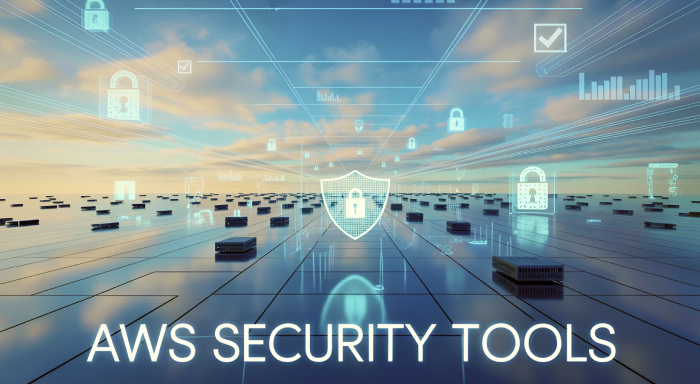With the rapid evolution of the digital world, new cyberthreats emerge every day. Cybersecurity has become a necessity, particularly in the cloud infrastructure, where attempts at data breaches are frequent. AWS security tools offer cost-effective solutions for identity management, threat detection, and data security. In this blog, we have listed 8 AWS security tools that are essential in the current cloud computing landscape.
What are AWS Security Tools?
Amazon Web Services is the leading cloud computing platform with over 200 fully functional services. It enables you to build new cloud applications or integrate existing applications with the cloud. AWS is the most widely adopted cloud platform across the globe. Therefore, many organisations worldwide are adopting these native AWS security tools for the protection of their infrastructure.
AWS security tools are a comprehensive set of AWS services that can secure the cloud infrastructure, workflow, and data against cyberattacks. Amazon offers a shared responsibility model with these tools. According to this model, the infrastructure would be secured by AWS, whereas the applications and data would be secured by the customers. These tools offer solutions for different segments of security, such as:
- Identity and access management
- Network security and firewalls
- Threat detection and monitoring
- Data encryption and protection
- Compliance auditing
8 Essential AWS Security Tools
The AWS security tools require minimal configuration, and some of them operate automatically. They address different security needs and integrate seamlessly with other AWS services, enabling a comprehensive security framework.
1. AWS Identity and Access Management (IAM)
AWS Identity and Access Management (IAM) acts as the first line of defence in any AWS environment. It enables precise control over user permissions, facilitating identity and access management. IAM allows integration with all AWS services, thus providing secure access control over the entire cloud infrastructure.
Key Features:
- Role-based users and groups access management.
- Precision-based permission control
- Multi-factor authentication
- Access pattern and usage monitoring
2. Amazon GuardDuty
Amazon GuardDuty is a threat detection security service. As the name suggests, the tool monitors the cloud infrastructure and guards it against malicious activities. It automatically analyses DNS logs, VPC flow logs, and CloudTrail activities to detect suspicious actions. It also provides detailed security findings for advanced resolution.
Key Features:
- Threat and anomaly detection with machine-learning algorithms
- Real-time monitoring
- Automated security analysis and alerts
- Integration with threat intelligence feeds
3. AWS CloudTrail
CloudTrail is an AWS security tool that facilitates extensive auditing. It provides transparency into user activity as it logs all API calls across the cloud environment. It improves risk mitigation through enhanced visibility into the actions. The regular auditing ensures governance and compliance.
Key Features:
- Real-time monitoring
- Comprehensive auditing; the logs are sent to Amazon S3 or CloudWatch
- Instant alerts through CloudWatch integration
- Compliance reporting
- Advanced analysis through integration with AWS Lake Formation
4. Amazon Inspector
Amazon Inspector conducts automated security evaluations. It scans the applications and workloads to identify software and network vulnerabilities. This AWS security tool monitors the cloud infrastructure continuously, making it ideal for DevOps environments where risks can be introduced due to frequent changes.
Key Features:
- Automated vulnerability assessments
- Integration with EC2 and AWS Systems Manager
- Network reach analysis
- Offers priority-based findings
5. AWS Security Hub
Security Hub provides a centralised view for security alerts from different AWS security tools and third-party solutions. This enables managing security operations at scale, especially in the case of organisations with distributed operations.
Key Features:
- Centralised dashboard
- Integration with multiple security tools like GuardDuty, Inspector, etc.
- Uses standard industry-relevant formats like CIS and PCI DSS
- Automation for compliance monitoring
6. AWS Config
AWS Config enables configuration management through audits and evaluations of resource configurations. It alerts you whenever there is a divergence, helping you to maintain security standards.
Key features:
- Real-time tracking of configuration changes
- Evaluation for compliance rules
- Relationship mapping for resources
- Snapshot of historical changes
7. AWS Key Management Services (KMS)
Encryption is an important step in data protection. AWS KMS enables you to create and manage cryptographic keys for data encryption across the infrastructure. You can protect sensitive information at rest and in transit.
Key features:
- Centralised key management
- Automatic key rotation
- Key usage auditing
- Integration with all AWS services
- Compliance with FIPS 140-2
8. Amazon Macie
Key features:
- Automated discovery of sensitive data in Amazon S3
- Data classification and protection
- Enables privacy compliance with GDPR, CCPA, and other regulations
- Analysis powered by machine learning
Best Practices for the Implementation of AWS Security Tools
The following practices are essential for the successful implementation of AWS security tools:
- Use IAM to specify access controls.
- Enable GuardDuty from the beginning.
- For centralised security management, use Security Hub.
- Maintain regular monitoring using CloudTrail.
- Encrypt the data.
- Automate compliance monitoring using Config.
Conclusion
Protecting the dynamic cloud infrastructure against rapidly evolving cyberthreats needs a comprehensive approach. The above-mentioned 8 AWS security tools enable you to establish a robust security framework that can reduce security risks while maintaining operational efficiency. They offer automated monitoring and logging, saving manual efforts. You can also ensure compliance with multiple regulations and data security protocols. Adopt the practices for successful implementation and establish a secure cloud environment.




%201.png)

%201.png)

%201.png)

